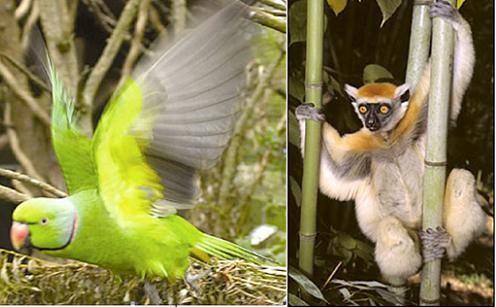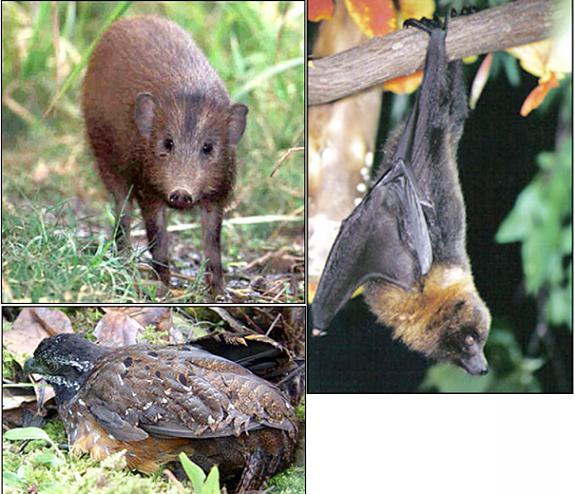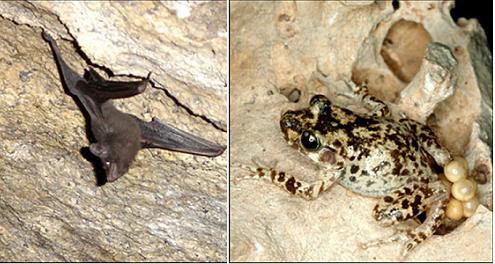Dr. Assaf Rosenthal

Endangered species
Since the announcements about 800 species in 595 places that are in immediate danger of extinction appeared in the written press below some illustrative pictures:
Right: In Madagascar, several species of lemurs, one of which is the golden-crowned sifaka/Propithecus tattersalli. The last individuals live in an area that grew to about 30 square kilometers. Not far from there in the south-west of the island of Mauritius live, according to an estimate, about 200 last parrots (Mauritius parakeets/Psittacula eques) in the picture on the left, the causes of their extinction are rats that prey on the eggs and chicks as well as competition for food sources by macaques, meaning two invasive / foreign species and especially the loss of living spaces.

Dwarf pig Sus salvanius lives with great difficulty only in a barnyard in India (top left); The slopes of the Andes in Colombia are the habitat of the wood-quail (bottom left) wood-quail/Odontophorus). Its population is estimated at 1000. The groves in which the Shalivu found his life are disappearing and so is the Shalivu. On the right Rodrigues flying fox/Pteropus rodricensis
Found today only on Rodriguez Island - in the Indian Ocean. About 70 recent individuals are "competing" in the harvesters.
The main reason for its disappearance is deforestation.

Another bat lives in the Seychelles (sheath-tailed bat / Coleura seychellensis). About a hundred individuals are known to be suppressed and disappear due to development for tourism needs. One of the many extinct species of amphibians living only in the north of Mallorca is the Mallorcan midwife toad / Alytes muletensis. The name comes from the fact that it is the male who carries the bag of fertilized eggs on his back. And all this is just a tiny sample of the destroyed beauty.
The Walla news site reports that the journal of the Academy of Sciences in the United States, "PNAS", published in its latest issue the global extinction map. According to the data, there are nearly 600 sites in the world that are the last places of refuge for 794 species.
Most of the sites are located in tropical areas, especially in the Americas, or on islands with unique wildlife, such as Madagascar. The information was collected by a new body called "Alliance for Zero Extinction" - an umbrella organization of the world's leading nature conservation organizations. The endangered species include mammals, reptiles, birds, amphibians and also some tree species. This publication is an important continuation of the research that led a few months ago to an international project called "Assessment of the State of Ecosystems in the Current Millennium".
According to scientists' estimates, the rate of extinction in the modern world is between one hundred and one thousand times higher than the natural rate of extinction. According to the data of the Ecosystems Project, it is known about a hundred species of mammals, amphibians and birds that became extinct only in the last hundred years.
Haaretz newspaper reports that one site in Israel, Mount Hermon, is also on the map of extinction. The rare animal that lives in it is a mouse called Yaron Hermoni, which was discovered for the first time only in 1989. It is a species found, apparently, only in Hermon, and possibly also in Lebanon. According to the "Red Book" of endangered species published by the green bodies in Israel, the main factor threatening the forestry is military activity that includes road construction, construction of buildings and skiing activities in the area.
Only a third of the sites on the global extinction map have legal protected status, and the vast majority of them are surrounded by a human population whose density is three times greater than the average density of the Earth's population; This means unrelenting pressure, which only exacerbates the fear of total extinction.
The main cause of species extinction is the destruction of their habitats as a result of human development activities such as cutting down forests, turning natural areas into agricultural land, establishing various types of infrastructure and the spread of built-up areas. According to the assessment of the Ecosystems Project, by the year 2050 about 20% of the areas of forests and natural grass that exist today in the world will disappear.
"Saving species is important as a goal in itself," Mike Parr, director of the Union for Zero Extinction, explained yesterday in Washington. "But we are talking about many other goals - among them saving the genetic diversity of the ecosystems that exist in the world and preserving eco-tourism in the world, the value of which is currently estimated at billions of dollars a year."
Representatives of several organizations partnering in the new study, stated this week that the preservation of the species must be done at the same time as the strengthening of the human communities that are in their neighborhood, especially in the developing countries. The spokesperson for the organization, named after the author Gerald Darrell, told the BBC that in countries like Madagascar, species conservation encourages donations to build water wells and schools, and thus the residents learn that there is benefit in conserving wildlife and mobilize for this purpose.
Also, the nature conservation organizations stated that the cost of saving some of the sites where species are in danger of extinction is not that high in many cases: sometimes it is possible to save a small site at a cost of less than a thousand dollars a year, but on the other hand there are sites where amounts of close to 4 million dollars a year are required to save them.
